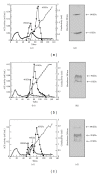N-domain isoform of Angiotensin I converting enzyme as a marker of hypertension: populational study
- PMID: 22666552
- PMCID: PMC3362081
- DOI: 10.1155/2012/581780
N-domain isoform of Angiotensin I converting enzyme as a marker of hypertension: populational study
Abstract
The aim of this paper was to investigate the presence of the urinary 90 kDa N-domain ACE in a cohort of the population from Vitoria, Brazil, to verify its association with essential hypertension since this isoform could be a possible genetic marker of hypertension. Anthropometric, clinical, and laboratory parameters of the individuals were evaluated (n = 1150) and the blood pressure (BP) was measured. The study population was divided according to ACE isoforms in urine as follows: ACE 65/90/190, presence of three ACE isoforms (n = 795), ACE 90(+) (65/90) (n = 186), and ACE 90(-) (65/190) (n = 169) based on the presence (+) or absence (-) of the 90 kDa ACE isoform. The anthropometric parameters, lipid profile, serum levels of uric acid, glucose, and the systolic and diastolic BP were significantly greater in the ACE 90(+) compared with the ACE 90(-) and ACE 65/90/190 individuals. We found that 98% of individuals from the ACE 90(+) group and 38% from the ACE 65/90/190 group had hypertension, compared to only 1% hypertensive individuals in the ACE 90(-) group. There is a high presence of the 90 kDa N-domain ACE isoform (85%) in the studied population. The percentile of normotensive subjects with three isoforms was 62%. Our findings could contribute to the development of new efficient strategy to prevent and treat hypertension to avoid the development of cardiovascular disease.
Figures



Similar articles
-
N-domain angiotensin I-converting enzyme with 80 kDa as a possible genetic marker of hypertension.Hypertension. 2003 Oct;42(4):693-701. doi: 10.1161/01.HYP.0000085784.18572.CB. Epub 2003 Aug 4. Hypertension. 2003. PMID: 12900433
-
Association of urinary 90 kDa angiotensin- converting enzyme with family history of hypertension and endothelial function in normotensive individuals.Braz J Med Biol Res. 2008 May;41(5):351-6. doi: 10.1590/s0100-879x2008005000017. Epub 2008 Apr 30. Braz J Med Biol Res. 2008. PMID: 18516470
-
N-Domain angiotensin I-converting enzyme expression in renal artery of Wistar, Wistar Kyoto, and spontaneously hypertensive rats.Transplant Proc. 2004 May;36(4):1001-3. doi: 10.1016/j.transproceed.2004.03.081. Transplant Proc. 2004. PMID: 15194348
-
Effects of renin-angiotensin system inhibition on end-organ protection: can we do better?Clin Ther. 2007 Sep;29(9):1803-24. doi: 10.1016/j.clinthera.2007.09.019. Clin Ther. 2007. PMID: 18035185 Review.
-
Cardiovascular and renal protection in type 2 diabetes mellitus: the role of calcium channel blockers.J Am Soc Nephrol. 2002 Nov;13 Suppl 3:S216-23. doi: 10.1097/01.asn.0000034687.62568.9b. J Am Soc Nephrol. 2002. PMID: 12466317 Review.
Cited by
-
Rosiglitazone treatment of type 2 diabetic db/db mice attenuates urinary albumin and angiotensin converting enzyme 2 excretion.PLoS One. 2013 Apr 30;8(4):e62833. doi: 10.1371/journal.pone.0062833. Print 2013. PLoS One. 2013. PMID: 23646149 Free PMC article.
-
Soluble urinary somatic angiotensin converting enzyme is overexpressed in patients with preeclampsia: a potential new marker for the disease?Hypertens Pregnancy. 2022 Aug-Nov;41(3-4):190-197. doi: 10.1080/10641955.2022.2115060. Epub 2022 Aug 23. Hypertens Pregnancy. 2022. PMID: 35997304 Free PMC article.
-
Characterization of angiotensin-converting enzyme 2 ectodomain shedding from mouse proximal tubular cells.PLoS One. 2014 Jan 15;9(1):e85958. doi: 10.1371/journal.pone.0085958. eCollection 2014. PLoS One. 2014. PMID: 24454948 Free PMC article.
-
Is It Still Relevant to Discover New ACE Inhibitors from Natural Products? YES, but Only with Comprehensive Approaches to Address the Patients' Real Problems: Chronic Dry Cough and Angioedema.Molecules. 2023 Jun 2;28(11):4532. doi: 10.3390/molecules28114532. Molecules. 2023. PMID: 37299008 Free PMC article. Review.
-
Pediatric dyslipidemia is associated with increased urinary ACE activity, blood pressure values, and carotidal-femoral pulse wave velocity.Hypertens Res. 2023 Jun;46(6):1558-1569. doi: 10.1038/s41440-023-01240-y. Epub 2023 Mar 24. Hypertens Res. 2023. PMID: 36959504
References
-
- Carretero OA, Oparil S. Essential Hypertension. Part I: definition and etiology. Circulation. 2000;101(3):329–335. - PubMed
-
- Kearney PM, Whelton M, Reynolds K, Muntner P, Whelton PK, He J. Global burden of Hypertension: analysis of worldwide data. The Lancet. 2005;365(9455):217–223. - PubMed
-
- Eriksson U, Danilczyk U, Penninger JM. Just the beginning: novel functions for angiotensin-converting enzymes. Current Biology. 2002;12(21):R745–R752. - PubMed
-
- Oparil S, Zaman MA, Calhoun DA. Pathogenesis of hypertension. Annals of Internal Medicine. 2003;139(9):761–776. - PubMed
-
- Kearney P, Whelton M, Reynolds K, Whelton PK, He J. Worldwide prevalence of hypertension: a systematic review. Journal of Hypertension. 2004;22(1):11–19. - PubMed
LinkOut - more resources
Full Text Sources
Other Literature Sources
Miscellaneous

